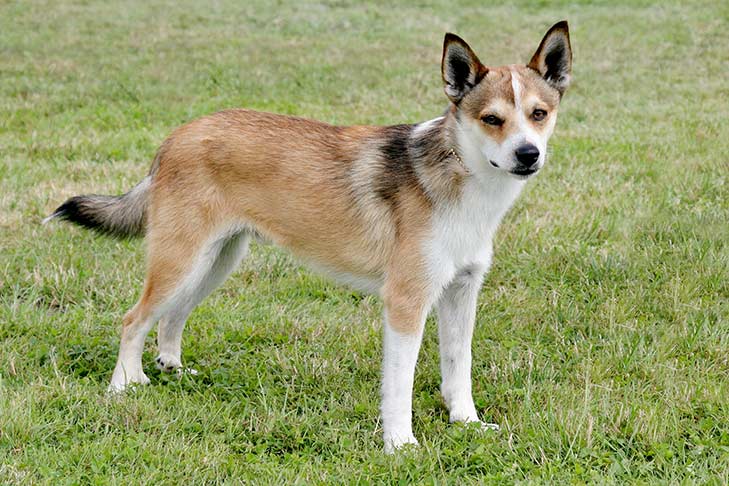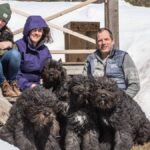Norwegian Lundehund is the only dog breed developed specifically for the task of puffin hunting. Since puffins are now a protected species, the Lundehund of today is a sociable, active companion.
With a large number of unique physical anomalies that developed due to the extreme environment in which they lived and worked, it can be a challenge to understand this breed. The heading in so many breed books, “Form Follows Function”, is no better illustrated than in the Lundehund.
Origins & Purpose
When observing a Norwegian Lundehund coming toward you, their rotary gait tends to surprise the observer. It only makes sense if you clearly understand the breed is built for vertical travel, not horizontal. The homeland for the Lundehund is an archipelago north of the Arctic Circle, the Lofotens.
The flexibility required to navigate the steep cliffs results in an elastic shoulder, allowing the dog to spread its legs to keep its balance while crossing the treacherous scree and up the cliff in search of puffins, a small marine bird that provided food for the native farmers and the comfort and warmth of down for the rest of Europe.
The Unique Norwegian Lundehund
The Norwegian Lundehund has many unique attributes but the one singular trait that sets the breed apart from all other dogs, is the fact that Lundehunds have six toes on each foot. Add too, that the fifth digit on the front foot acts as an opposable thumb and should be appropriately long so that it can provide support when the dog stands.
Judges should inspect each foot individually to confirm the number of toes and note the corresponding pads. The central pad on the back foot has elongated over time (in an evolutionary fashion) so that it acts as a brake when the Lundehund is going down the cliffs.
There are two ways in which to inspect the feet and toes. One may do so by picking up the individual feet for inspection or ask the handler to show them the dog’s feet.
- In the first scenario, the judge inspects each foot while going around the dog, taking care to life each foot off the ground making the pads visible.
- Under the second scenario, the handler would pick the dog up so that the judge can easily approach the dog and quickly go over the feet. Being well-versed on the Lundehund’s feet is critical for any judge and particularly at Specialties where they include a Special Attraction of BEST FEET. Special consideration/reverence is given to the recipient of this award because of the importance of the feet in the breed.
Proportions
The height range for a Norwegian Lundehund is 12″-14″ for bitches and 13″-15″ for dogs though it should be noted that these are guidelines; there are no disqualifications in the AKC standard of the Norwegian Lundehund. Weight should be in proportion to the dog’s height, bearing in mind that what is being sought is an agile dog that is capable of squeezing itself into the entries of puffin caves and be able to turn itself around in order to exit with at least one puffin in its mouth.
Living with a Norwegian Lundehund
If you can imagine what it would be like to watch Norwegian Lundehunds climbing and digging to get to the puffins you should have no problem imagining them doing the same thing in your kitchen cupboard, but this time looking for a hidden treasure (in this case I allowed one of mine to enter a corner cabinet where she promptly deposited her bone then came back to claim it a day later).
Living with a Lundehund is a wonderful and charming experience given you approach life with a sense of humor and forgiveness. Lundehunds are terribly clever and class A problem solvers. It is extremely difficult to outwit a Lundehund so it’s suggested that you try only when absolutely necessary lest the Lundie begin to lose their trust in you. Trust is a big issue and difficult to regain if lost. The most important thing to a Lundehund, after food, is closeness with its people, both literally and figuratively.
Food is mentioned because of the strong drive for survival and the role food plays. In the frozen north of Norway, the Lundehund would eat whatever presented itself. Today a high protein and low fat diet is what is recommended, preferably grain-free, then the dog will follow that with whatever presents itself (dessert?). It is not uncommon to find your Lundehund grazing on blackberries straight off the vine or taking the leaves from something in a flower bed and enjoying a nice “salad” or scrambling to get the accidentally dropped piece of cheese.
Nutrition
In addition to the high protein/low fat diet, veterinarians recommend testing the albumen and total protein levels with some frequency, perhaps quarterly. There is a predisposition to suffer from a protein-losing enteropathy which may be more responsive to treatment if you catch it early on in its development. There is some belief that all Lundehunds are susceptible to the protein losing enteropathy because just fifty years ago the world’s population was a mere six dogs. Found in the Lofoten Islands, five of these original six were siblings, making for a very tight gene pool.
Are you looking for a Norwegian Lundehund puppy?
The best way to ensure a long and happy relationship with a purebred dog is to purchase one from a responsible breeder. Not sure where to begin finding a breeder? Contact the National Parent Club’s Breeder Referral person, which you can find on the AKC Breeder Referral Contacts page.
Want to help rescue and re-home a Norwegian Lundehund dog?
Did you know nearly every recognized AKC purebred has a dedicated rescue group? Find your new best friend on the AKC Rescue Network Listing.
Norwegian Lundehund Dog Breed Magazine
Showsight Magazine is the only publication to offer dedicated Digital Breed Magazines for ALL recognized AKC Breeds.
Read and learn more about the unique Norwegian Lundehund dog breed with articles and information in our Norwegian Lundehund Dog Breed Magazine.
Error embedding FlippingBook shortcode, please check the flipbook url. (https://digital.showsightmagazine.com/view/328425/)









